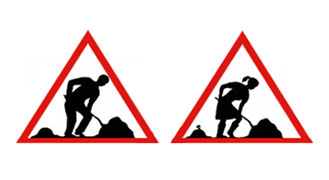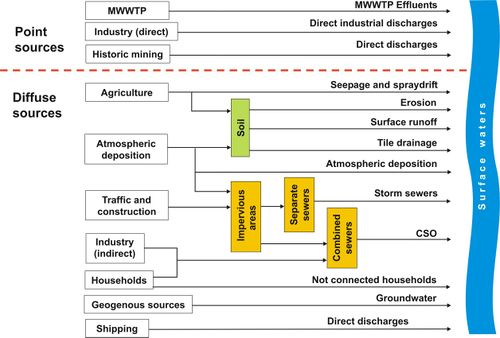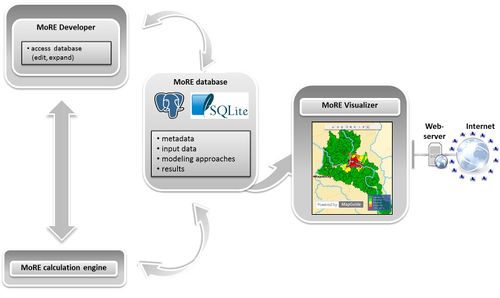Difference between revisions of "The model system MoRE"
IWG-MoRE-en (talk | contribs) |
IWG-MoRE-en (talk | contribs) |
||
| Line 8: | Line 8: | ||
[[File:emissions_pathways.jpg|thumb|500px|Substance sources and emission pathways for water pollution (Fuchs et al., 2010)|link=]] |
[[File:emissions_pathways.jpg|thumb|500px|Substance sources and emission pathways for water pollution (Fuchs et al., 2010)|link=]] |
||
[[File:system_architecture.jpg|thumb|500px|System architecture of the open source model MoRE|link=]] |
[[File:system_architecture.jpg|thumb|500px|System architecture of the open source model MoRE|link=]] |
||
| + | |||
| + | |||
| + | The Directive 2008/105/EC (on environmental quality standards) of the European Parliament and the Commission<ref name="EG">European Parliament and the Commission: ''Directive 2008/105/EC of the European Parliament and of the Council of 16 December 2008 on environmental quality standards in the field of water policy, amending and subsequently repealing Council Directives 82/176/EEC, 83/513/EEC, 84/156/EEC, 84/491/EEC, 86/280/EEC and amending Directive 2000/60/EC of the European Parliament and of the Council'', 2008</ref> asks the member states for an emission inventory of priority substances for all river basin districts. This task requires appropriate data and approaches to describe the current state of surface water bodies and to evaluate appropriate measures for the reduction of emissions into the surface water bodies. The overall aim is to achieve a good ecological state of surface waters and to comply with the quality standards. |
||
| + | |||
| + | To meet these demands, the established MONERIS nutrient emission modeling system <ref name="Behrendt"> Behrendt, H., Huber, P., Kornmilch, M, Ley, M., Opitz, D., Schmoll, O., Scholz, G. & Uebe,R. (1999): ''Nährstoffbilanzierung der Flußgebiete Deutschlands.'' UBA Texte, 75/99</ref>, was adapted to the modeling of pollutant emissions into water bodies and implemented in an open source environment as the river basin management system '''MoRE (Modeling of Regionalized Emissions)'''. |
||
| + | |||
| + | The following emission pathways are implemented in MoRE: |
||
| + | |||
| + | * Pathways with point sources: |
||
| + | ** Municipal wastewater treatment plants |
||
| + | ** Industrial direct dischargers |
||
| + | ** Emissions of historic mining sites |
||
| + | * Pathways with diffuse sources: |
||
| + | ** Erosion |
||
| + | ** Surface runoff |
||
| + | ** Tile drainage |
||
| + | ** Direct atmospheric deposition onto water surfaces |
||
| + | ** Sewer systems |
||
| + | ** Groundwater |
||
| + | ** Inland navigation |
||
| + | |||
| + | In addition to modeling emissions into the water bodies, an estimation of the river load on the basis of total emissions and a substance-specific retention is carried out. The modeling approaches and sources of input data are described in detail in [https://www.umweltbundesamt.de/publikationen/berechnung-von-stoffeintraegen-in-fliessgewaesser Fuchs et al. (2010)] <ref name="Fuchs2010"> [https://www.umweltbundesamt.de/publikationen/berechnung-von-stoffeintraegen-in-fliessgewaesser] |
||
| + | Fuchs, S., Scherer, U., Wander, R., Behrendt, H., Venohr, M., Opitz, D., Hillenbrand, Th., Marscheider-Weidemann, F., Götz, Th. (2010): ''Berechnung von Stoffeinträgen in die Fließgewässer Deutschlands mit dem Modell MONERIS. Nährstoffe, Schwermetalle und Polyzyklische aromatische Kohlenwasserstoffe.'' UBA-Texte 45/2010, Dessau </ref> and [https://www.umweltbundesamt.de/publikationen/effizienz-von-massnahmen-zur-reduktion-von Fuchs et al. (2017)]<ref name="Maßn.eff">[https://www.umweltbundesamt.de/publikationen/effizienz-von-massnahmen-zur-reduktion-von]Fuchs, S., Weber, T., Wander, R., Toshovski, S., Kittlaus, S., Reid, L., Bach, M., Klement, L., Hillenbrand, Th., Tettenborn, F. (2017): ''Effizienz von Maßnahmen zur Reduktion von Stoffeinträgen - Endbericht'', UBA Texte | 05/2017</ref>. |
||
| + | |||
| + | |||
| + | |||
| + | |||
| + | |||
| + | |||
| + | |||
| + | = References = |
||
| + | |||
| + | <references /> |
||
Revision as of 14:16, 2 April 2019

Model development
The Directive 2008/105/EC (on environmental quality standards) of the European Parliament and the Commission[1] asks the member states for an emission inventory of priority substances for all river basin districts. This task requires appropriate data and approaches to describe the current state of surface water bodies and to evaluate appropriate measures for the reduction of emissions into the surface water bodies. The overall aim is to achieve a good ecological state of surface waters and to comply with the quality standards.
To meet these demands, the established MONERIS nutrient emission modeling system [2], was adapted to the modeling of pollutant emissions into water bodies and implemented in an open source environment as the river basin management system MoRE (Modeling of Regionalized Emissions).
The following emission pathways are implemented in MoRE:
- Pathways with point sources:
- Municipal wastewater treatment plants
- Industrial direct dischargers
- Emissions of historic mining sites
- Pathways with diffuse sources:
- Erosion
- Surface runoff
- Tile drainage
- Direct atmospheric deposition onto water surfaces
- Sewer systems
- Groundwater
- Inland navigation
In addition to modeling emissions into the water bodies, an estimation of the river load on the basis of total emissions and a substance-specific retention is carried out. The modeling approaches and sources of input data are described in detail in Fuchs et al. (2010) [3] and Fuchs et al. (2017)[4].
References
- ↑ European Parliament and the Commission: Directive 2008/105/EC of the European Parliament and of the Council of 16 December 2008 on environmental quality standards in the field of water policy, amending and subsequently repealing Council Directives 82/176/EEC, 83/513/EEC, 84/156/EEC, 84/491/EEC, 86/280/EEC and amending Directive 2000/60/EC of the European Parliament and of the Council, 2008
- ↑ Behrendt, H., Huber, P., Kornmilch, M, Ley, M., Opitz, D., Schmoll, O., Scholz, G. & Uebe,R. (1999): Nährstoffbilanzierung der Flußgebiete Deutschlands. UBA Texte, 75/99
- ↑ [1] Fuchs, S., Scherer, U., Wander, R., Behrendt, H., Venohr, M., Opitz, D., Hillenbrand, Th., Marscheider-Weidemann, F., Götz, Th. (2010): Berechnung von Stoffeinträgen in die Fließgewässer Deutschlands mit dem Modell MONERIS. Nährstoffe, Schwermetalle und Polyzyklische aromatische Kohlenwasserstoffe. UBA-Texte 45/2010, Dessau
- ↑ [2]Fuchs, S., Weber, T., Wander, R., Toshovski, S., Kittlaus, S., Reid, L., Bach, M., Klement, L., Hillenbrand, Th., Tettenborn, F. (2017): Effizienz von Maßnahmen zur Reduktion von Stoffeinträgen - Endbericht, UBA Texte | 05/2017

